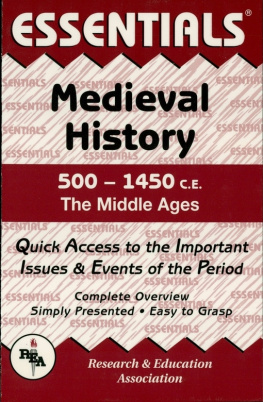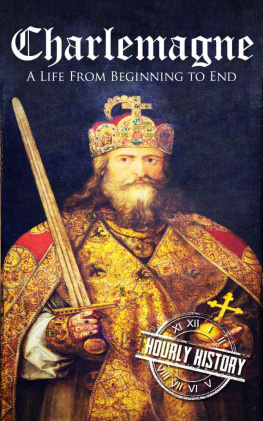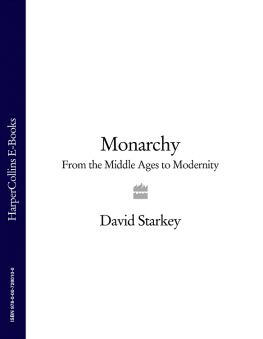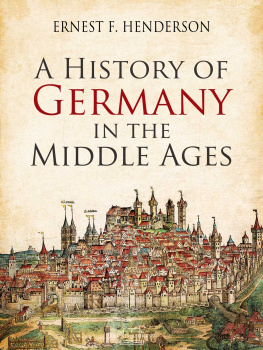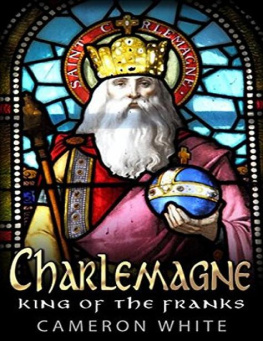THE
MIDDLE
AGES
Johannes Fried
Translated by Peter Lewis
THE BELKNAP PRESS OF
HARVARD UNIVERSITY PRESS
Cambridge, Massachusetts
London, England
2015
Copyright 2015 by the President and Fellows of Harvard College
All rights reserved
This book was originally published as Das Mittelalter, 3rd ed., copyright Verlag C. H. Beck oHG, Munchen 2009.
Jacket art: Hans Memling (ca. 14331494), detail of Portrait of a Man Holding a Coin of the Emperor Nero (oil on panel, ca. 14731474). Koninklijk Museum voor Schone Kunsten, Antwerp, Belgium / Giraudon / Bridgeman Images
Jacket design: Annamarie McMahon Why
The Library of Congress has cataloged the printed edition as follows:
Fried, Johannes.
[Mittelalter. English]
The Middle Ages / Johannes Fried ; translated by Peter Lewis.
pages cm.
This book was originally published as Das Mittelalter, 3rd ed., copyright (c) Verlag C. H. Beck oHG, Munchen 2009.
Includes bibliographical references and index.
ISBN 978-0-674-05562-9 (alk. paper)
1. EuropeHistory476-1492. 2. Civilization, Medieval. I. Lewis, Peter (Translator) II. Title.
D117.F8513 2015
909.07dc23
2014014404
Contents
The customary schema of historical erasAntiquity, the Middle Ages, and the Modern Agecame into being at the end of the medieval period, but over the course of time its configuration has changed. It may have had its origins, as Johan Huizinga suggested, in the popular conception of a tripartite formula widely employed by heralds in the fifteenth century, which clearly demarcated the almost legendary period of Prehistory from their own present, and inserted between them a middle era, temps moien, in other words a period that went back to the farthest limit of human historical recollection. Whether experienced as the present, as living memory, or as an ideal prehistory, the notion of a period lying between the contemporary age and the age of heroes and gods, of the patriarchs and matriarchs, occurs, albeit under various different designations, across a wide range of the worlds civilizations. Yet mere identification of this kind of interim period did not in itself give rise to the concept of the Middle Ages. In his Historiarum ab inclinatione Romanorum imperii decades (written between 1439 and 1453, and printed in 1483), the great humanist Flavio Biondo takes a more lucid and scholarly approach than any attempted hitherto (whether by heralds or in the popular imagination), presenting the historical period since the fall of the Roman Empire as a middle age extending from the conquest of Rome by barbarian Goths in 410 to the present; the humanist-educated Johannes Andreas (Giovanni Andrea Bussi), bishop of Aleria in Corsica, picked up on this concept in 1469, when he ascribed to the great scholar and cardinal Nicholas of Cusa a broad knowledge of the history and literature of three epochs: antiquity (priscae [tempestates]), the interim period (media tempestas), and the present day (nostra tempora). This formulation reached German humanists through the Latin world-chronicle of Hartmann Schedel (1493). However, at this stage, the idea of an era in its own right still did not exist. Such a concept was only devised by authors in later centuries, during the Baroque period and the Enlightenment. True, these commentators did not set hard-and-fast boundaries to this middle periodsome dated it from Constantine the Greator from A.D. 500 or 600to the Reformation, while others saw it as having lasted variously to 700, or up to around 1100, or to the conquest of Constantinople by the Seljuk Turks in 1453, or even to other, quite different cutoff points. But even so, their endeavors only succeeded in presenting this middle age as some distant, self-contained era with no connection to the here and now, and in so doing gave the period its own identity. Specific hallmarks to corroborate this very rigid image of the period were soon invented. Henceforth, the Middle Ages changed from being barbarian and dark to being meaningful and enlightened, though this development brought its own particular dangers. Indeed, even up to the present day, various nationalisms and ideologies still appeal to a medieval period as defined by them to suit their own ends.
The present work therefore has as its subject matter a contentious phenomenon that has been shaped by contradictory and opposing traditions. It will thus eschew postulating any homogeneous picture of the Middle Ages or constructing any hermetically sealed whole. It will rather attempt to pursue certain lines of development through a millennium whose beginning and end have been solely determined by the customary practice of German university faculties of assigning responsibility for the period between around 500 to circa 1500 to those charged with teaching medieval studies; elsewhere, things are organized differently, with far-reaching implications for the tendentious concept of the Middle Ages.some irreducible identity, but meant simply to designate the given time span of 1,000 years or so.
In such an overview of a millennium, which aims to present humans of flesh and blood and not just trends and structures, it will naturally be impossible to treat the full range of all details exhaustively. Only the most stringent selection is possible, and this is of necessity subjective. The flow of the narrative will sometimes take a broad and straight course, while on other occasions it will split into tributaries, or flow around islands, but then its streambed will narrow once more, hastening the onward flow. Whatever it carries with it from here or there stands as an exemplar of many similar things, and hence should be regarded as symptomatic of cultural evolution beholden to the human spirit and as the social development of cultures of knowledge. The same applies to those particular historical instances that we have chosen to light upon as prime examples of the complexity of events within the realm of politics and power. Abstractionsthe monk, the knight, the townsmanhave been avoided. Rather, this account focuses on certain individualssometimes a pope, sometimes a king, or a scholar, a missionary, or an enterprising merchant. Their encounters with the unfamiliar, their grappling with new ideas, or religious movements, or scientific disciplines, their scope of action, and the expansion of their culture of knowledge are examined within the framework of political constellations of power and the proliferation of international relations, the growing complexity of societies, and functional differentiation.
Our focus, then, is firmly fixed upon cultural evolution, with both its continuities and discontinuities; and, just like any natural evolution, this does not develop teleologically. Only in retrospect does it appear to the historian to be linear, logical, and oriented toward progress. It is therefore a construct, necessarily subjective, no less so indeed than all the other spheres of reality in which we humans navigate, move, and act. It is a hypothesis, whose plausibility is conditioned by unprovable premises, our own subjective experiences, and familiar structural patterns. There can be no such thing as a generally binding history, any more than my reality could be your reality, even though both are indisputably forms of reality. Likewise, the simultaneity of events also defies any authoritative account, since once such an account has been given, it is forever consigned to posterity, and is only capable of sequentially considering, combining, or describing things that in actual fact had a concurrent effect and were contingent upon one another and intermeshed in their impact. This is also consonant with our cognitive makeup as human beings, which prevents us from grasping simultaneity immediately, through our sensory perception, but which, rather, allows us to piece it together only in retrospect, on reflection, by adducing information from third parties and by deploying countless methodical preconditions and artifices. Flashbacks, forward shifts in time, and more minor interpolations by way of digression can only be an unsatisfactory literary expedient; for the same reason, it is impossible to avoid brief repetitionsthese are quite intentional. Nonetheless, our intention is still to present an overview of a whole, namely that evolution mentioned above, a development that drew its dynamism from the confluence of political, social, religious, cultural (in the widest sense), economic, scientific, and natural forces, and whose guiding thread in the labyrinth of chance occurrences and exigencies, of plans and reactions, is constituted by the growth of the culture of reason in those supposedly middle centuries.



